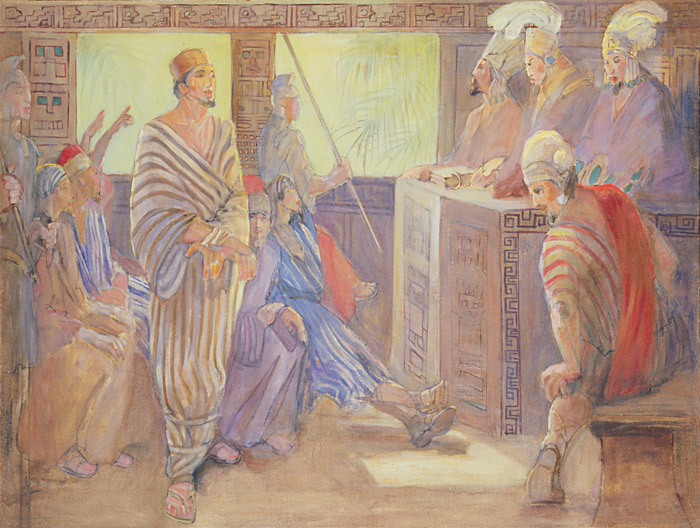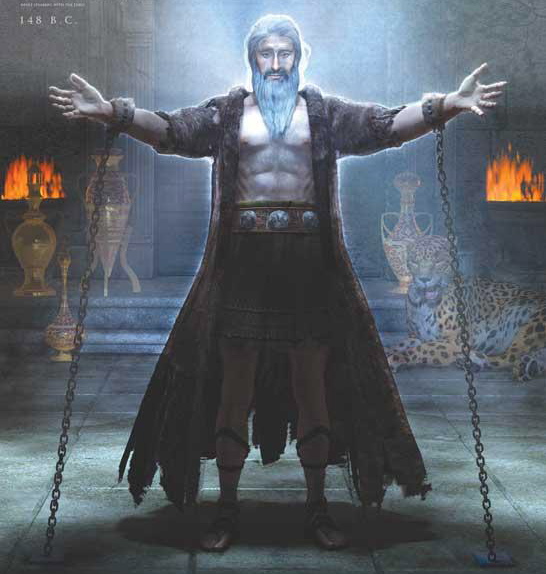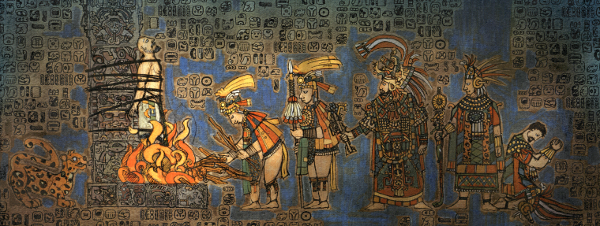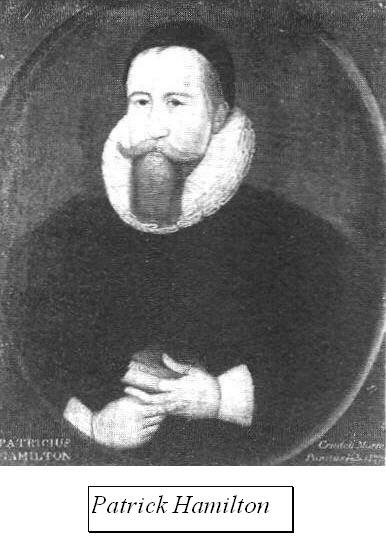.
MOSIAH 12-17
In the following chapters we get a continuation of the prophet Abinadi’s ministry to the Nephite people and their king, Noah, who live in the land of Nephi
Abinadi Prophecies Destruction
12: 2 This prophecy is fulfilled in Mosiah 21:2-4.
12:3 This prophecy is fulfilled in Mosiah 19:20.
12:5 This prophecy is fulfilled in Mosiah 21:2-4.
12:6 This is one of the few indications of what the weather could be like in the Book of Mormon lands – “hail” and “east wind”. However, one gets the sense that these are not the normal climate conditions.
Abinadi Arrested and Accused
12:9-12 It is interesting that out of all the similes mentioned in these verses, only the simile regarding “as a garment in a furnace of fire” is actually spoken of by Mormon when quoting Abinadi. Yet, the people of Noah include several more similes used as accusations in these verses that weren’t previously mentioned in verse 3. This begs the question, was this an editorial decision by Mormon, or were the people of Noah putting words in Abinadi’s mouth?
THE TRIAL OF ABINADI 12:17-17:20
12:17-24 Abinadi is Questioned about Isaiah 52:7-10.
12:25-37 The priests are questioned by Abinadi. Compare with Exodus 20:1-4.
12:29 Here it is interesting that Abinadi, when speaking of the Law of Moses, says nothing of the Levitical Laws. Instead, keeping the Law of Moses consisted of the following: not “setting you hearts upon riches”, not “committing whoredoms” and “spending your strength with harlots”,(how does one spend their strength with harlots anyways?), and not “causing the people to commit sin”.
The Ten Commandments (Exodus 20:4-17)
13:12 This verse picks up the quotation of Exodus 20:4 from Mosiah 12:36, although the verses quote Exodus slightly differently.
13:20-24 These last 5 commandments are curious. The first 5, that deal with God, provide reasons for the commandments. Those dealing with how we are to treat others, offer no reason for treating people as such. Is that because the last five are more intuitive?
The Law of Moses
13:27, 31 and Alma 25:15 The primary sources that Mormon uses influence his own writing. There are nearly two hundred instances in which his narration incorporates phrases he has picked up from embedded documents.
13:28 “And were it not for the atonement, which God Himself shall make for the sins and iniquities of his people, that they must unavoidably perish…” Two Sundays ago I went out with the full time missionaries in our ward. The gentleman we were talking to presented an argument against the atonement that sounded very similar to one I have heard Christopher Hitchens say. It was an objection to the fact that God would require either the sacrifice of an animal or a man in order for mankind to be redeemed. I explained, “It is not merely a man that atoned for our sins, but it was God Himself that offered Himself as an atonement.”
13:29 “even a very strict law” One of the arguments I have heard against the existence of objective moral values and duties is that God has said one thing at one time and then required something different at another time. God however understands that at times, we are unable to follow a certain moral law, and so he accommodates our shortcomings by simplifying.
Abinadi Cites Prophecies of Christ (Isaiah 53:1-12)
13:33 This is a possible reference to Deuteronomy 18:18-19; also compare to 1 Nephi 22:20,21. “Redeem his people” occurs nine times in the Book of Mormon; of those nine, five references belong to these two narratives (Mosiah 13:33, 15:1, 11,; Alma 11:40; Helaman 5:10); the last is a quotation of Amulek at Ammonihah.
There are some historical problems with Abinadi (who would have lived around 150 B.C) quoting Isaiah 53.
- Isaiah 53 is part of what is known as “Deutero-Isaiah” (Isaiah chapters 40–55). These chapters, according to scholars, are the work of a 6th-century BC author writing near the end of the Babylonian captivity. This would have been after Lehi left Jerusalem.
- Isaiah 53 was not interpreted as referring to the Messiah until after Jesus had been crucified and Christians began to look at Hebrew scripture to see if there were any prophecies of a “suffering Messiah.” This should not be shocking as Mormons have done the same thing with Ezekiel 37:16 which is a prophecy of the re-uniting of the Kingdoms of Israel and Judah. LDS have also interpreted it as a prophecy of the coming forth of the Book of Mormon; both can be true.
“Fourth Servant Song, commonly referred to as “Isaiah 53”, where the Sages all agree that the servant is the righteous remnant of Israel, and henceforth referred to as Israel. Consequently, from the perspective of Judaism, “Isaiah 53” is not a passage about ָמ ִׁשי ַח (maSHI’ah), the promised King/Messiah, of Judaism, in its plain reading…..the common reference terms used in the Hebrew Bible for the promised Messiah, such as David, son of David, or king, are conspicuously absent from the plain text of “Isaiah 53”. Moreover, a suffering and dying Messiah is not part of the traditional Jewish messianic paradigm, according to which the promised future king of (a united) Israel, shows up only once and will successfully execute the messianic agenda, as , ָמ ִׁשי ַח it is described in the Hebrew Bible, during his reign.”(http://thejewishhome.org/counter/Isa53JP.pdf)
Christ as the Father and the Son
Mosiah 15 contains some confusing verses. It has been argued by some that it contains a clear Trinitarian Doctrine suggesting that this was what Joseph Smith Jr. originally held to and that the different versions of the First Vision confirm this earlier Trinitarian belief.
To understand the Mormon view of God the Father and God the Son, it helps to understand the Trinitarian Doctrine and it’s history. The Council of Nicaea was held to determine how Jesus could be both divine and human and to determine how Jesus and God the Father are one. Two opposing views were presented. To understand the differences, we have to understand the two Greek words that were being discussed: homoousios and heteroosius. Homoousios means “of the same substance” while heteroosius means “of different substance.” The debate was whether Jesus was homoousios with the Father or heteroousios with the Father. Was Jesus begotten or created? Just like a child who is begotten of his parents, contains the same genetic material and therefore is of the same substance and nature, it was argued by the early church father Athanasius, that Jesus was begotten and thus of the same substance as the Father; cats beget kittens, dogs beget puppies. Arius (who was later decreed a heretic) claimed that Jesus was not begotten, but created by the Father. Thus he was not of the same substance. The difference would be an artist creating a painting (not of the same substance and nature as the artist) vs. the artist having a child (of the same substance and nature) . There was a third view that was also presented to the Council of Nicea; a sort of the middle road view. It claimed that Jesus was homoisos with the Father, or of “similar substance”. What’s the difference between homoisis and homoousios? The Greek letter “iota” . So when people use the idiom, “I don’t give one iota,” it is a reference to the Council of Nicaea and the debate that went on there. The view that won was that Jesus was homoousios with the Father and from that we get the Nicene Creed – one God, three different persons. This is theologically different from saying three distinct beings.
How does that differ from the Mormon view of the God Head? I would argue that Mormons hold to the view that Jesus is homoousios with the Father, but they are two distinct beings. Jesus was begotten in a pre-extence. I would argue that Mormonism teaches that all humans, to some extent, are also homoousios with our Father in Heaven. Our spirits were not merely created, but begotten as well. We existed in some kind of metaphysical form that was co-eternal with the Father called “intelligence.” We can see how logical our doctrine of deification would be with this view.
Here are some questions worth exploring within the realm of Mormon orthodoxy:
- Why and how was Jesus God in a pre-existent state?
- How does Mormonism’s view of the God Head fit in (or does it even need to?) with the classic Abrahamic monotheistic religions of Christianity, Judaism, and Islam?
- When Jehovah condescended to become human, did He give up some of His divine attributes? Or, did He add humanity to His divinity? The former leads to some theological thickets. If He gave up some of His divinity, which parts? His omniscience? His omnipotence?
The view that God gave up part or all of His divinity to become human was actually a heresy that was condemned by the early Christian church. This view is called Kenotic Theology. It is derived from the Greek words “kenos” and “kenoo”. These words mean “to empty.” This view is rooted in Philippians 2:5-11:
5 Let this mind be in you, which was also in Christ Jesus:
6 Who, being in the aform of God, thought it not robbery to be bequal with God:
7 But made himself of no reputation, and took upon him the form of a aservant, and was made in the likeness of men:
8 And being found in afashion as a man, he bhumbled himself, and became cobedient unto ddeath, even the edeath of the cross.
9 Wherefore God also hath highly aexalted him, and given him a bname which is above every name:
10 That at the aname of Jesus every bknee should bow, of things in heaven, and things in earth, and things under the earth;
11 And that every tongue should confess that Jesus Christ is aLord, to the glory of God the Father.
Philippians 2:7 The phrase “made himself of no reputation” comes from the Greek word “kenoo”, which means “to empty.”
_______________________________________________________
Mosiah 15;1 I think we as Mormons sometimes forget that it was God Himself that atoned for our sins. That is God the Son
15:4 “The very Eternal Father” is restricted in its use to Abinadi’s discourse and to Alma 11:38,39.
15:6 “Many mighty miracles” Mormon later incorporates this phrase into his binary framework in Mormon 9:18.
15:8 “Bands of death” is first introduced by Abinadi, who employs it five times, and then it occurs three times in Alma 5.
15:14-17 Abinadi suggests that some prophecies might be continuously operable, identifying the welcoming heralds of Isaiah 52:7 as prophets “who have published peace,” as well as “those that are still publishing peace” and “those who shall hereafter publish peace, yea, from this time henceforth and forever.”
15:24 Here we learn of the doctrine of the First Resurrection.
15:29 Here Abinadi is quoting Isaiah Chapter 52. The Book of Isaiah contains four passages commonly known as the Four Servant Songs: (1) Isaiah 42:1-4, (2) Isaiah 49:1-6, (3) Isaiah 50:4-9, (4) Isaiah 52:13- 53:12. Abinadi is not quoting any of the Four Servant Songs in this verse.
Compare 16:8 to Alma 27:28 Here again Mormon uses a primary source to have an effect on his readers and then this same primary source later influences his own writing (“Death is swallowed up”; “Victory”).
16:10; Alma 5:15; 1 Corinthians 15:53,54 It is clear that Alma is quoting Abinadi and not Paul. “Corruption/incorruption” appears six times in the Book of Mormon, but only Alma and Abinadi add the “mortal/immortality” corollary, and the two above Book of Mormon verses are the only ones in the Book of Mormon that add the specific wording of standing before God to be judged.
17:4 It is because of Alma that we know of Abinadi and King Noah. When were Alma’s records incorporated into the Large Plates of Nephi?
17:8 “Thou hast said that God himself should come down among the children of men:” I have found that among my fellow parishioners, there is a hesitancy and a lack of understanding that Jesus is God. I have heard it said by Mormons that it was Jesus, not God, that died for our sins. Such a claim would be what King Noah and his priests espoused.
17:15, 18, 20 “Death by fire” occurs six times in the Book of Mormon, but always in relation to the martyrdom of Abinadi; Mosiah 19:20; Alma 25;9, 11.
17:18 Mormon is keen to demonstrate the rationality of faith by citing the successful fulfillment of prophecy. For this type of argument to be persuasive, it is important that the original predictions be authentic – a quality that can best be inferred when prophecies are presented within embedded documents, with particular details, in the voice of the prophet himself, before their fulfillment. Predictions that were remembered or reconstructed after the fact, in the words of the narrator, would not carry the same evidentiary weight. Nevertheless, Mormon is not above helping his readers make connections by referring to or even quoting the original prophecy at the time it comes to pass, or using parallel language to record the fulfillment of a prediction. For example, Abinadi warns his executioners that “ye shall suffer, as I suffer, the pains of death by fire.” Later Mormon reports that “they were angry with the king, and caused that he should suffer, even unto death by fire” (Mosiah 19:20; Alma 25:9, 11).
This example can serve as a reminder that there is more to the subject of embedded documents than just noting where Mormon incorporates such sources and speculating as to which of their inherent characteristics most impressed him. To do so is to reduce his editorial efforts to a simple either/or decision: Should I include this document or not? But it is also instructive to teach how he integrates documents into his narrative – where he places them; how he sets the scene for firsthand accounts or follows up on them later; whether they move forward or disrupt particular story lines, and whether they reinforce or call into question themes in the main narrative. Mormon reveals a great deal about his historiographical inclinations through his handling of primary sources, and we can see how he employs this technique to strengthen the coherence of his history, to avoid discussing certain subjects, or to highlight a resonant implication.
17:19 “How long, O Lord, shall darkness brood over this realm? How long wilt thou suffer this tyranny of man? Lord Jesus, receive my spirit.” Protestant reformer and martyr Patrick Hamilton (1504 – 1528)









Recent Comments